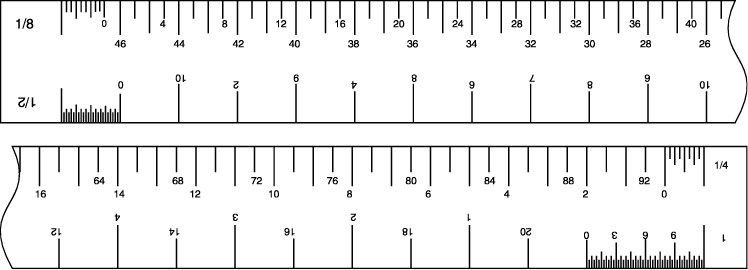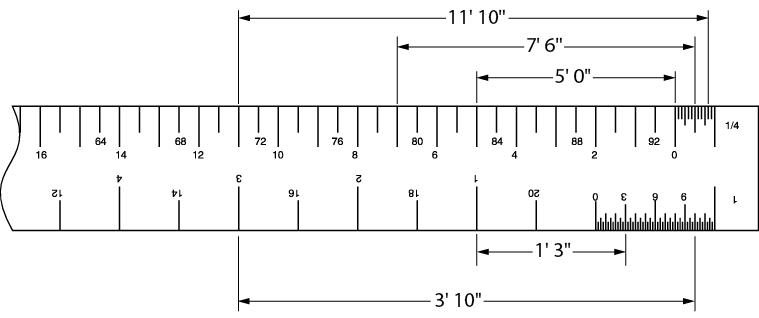4.2.2.2: Using an Archetects Scale Ruler
- Page ID
- 177890
Architect’s (imperial) scales
Traditional architectural measurements of length are written very precisely in feet and inches using the appropriate symbols for feet and inches separated by a dash (e.g., 4'-3 ½" and 7'-0"). This is the way that all imperial measurements are written on construction drawings. In the united states, we use imperial measurements of feet an inches, not the ubiquitous metric system of meters used across the world.
Listed below are the scales found on the architect’s triangular scale ruler.
- 3/32" =1'-0"
- 3/16" = 1'-0"
- 1/8" = 1'-0"
- ¼" = 1'-0"
- ¾" = 1'-0"
- 3/8" = 1'-0"
- 1" =1'-0"
- ½" = 1'-0"
- 1½" = 1'-0"
- 3" = 1'-0"
- 1" = 1" (full size—use the scale Labeled 16)
Figure 3 shows one face of an architect’s imperial triangular scale ruler. There are two edges on each face and each edge contains two scales that run in opposite directions. At each end of an edge, a number or fraction indicates the distance in inches that represents one foot. The top edge is in eighths of an inch from left to right, and in quarters of an inch from right to left. Note that the 1/8" scale from 0 to the right end represents 95 feet, and the ¼" scale from 0 to the left end represents 47 feet. Whenever using a scale ruler, always begin your measurement at "0" and slowly slide the ruler over until you have the end of the line you are measuring in alignment with an even foot measurement.
Inches
The small lines at the end of the ruler represent one total foot in that scale. The small hash marks evenly divide that foot into inches and fractions of an inch.

- One face of an architect’s ruler (NTS)

- Units in an architect’s scale ruler (NTS)

- Reading dimensions using an architect’s ruler (NTS)

- Reading dimensions using an architect’s ruler (NTS)
 Architectural units have feet divided into inches, whereas engineering units divide feet into tenths and hundredths. Engineers’ scales and metric scales are not used in theatre.
Architectural units have feet divided into inches, whereas engineering units divide feet into tenths and hundredths. Engineers’ scales and metric scales are not used in theatre.

